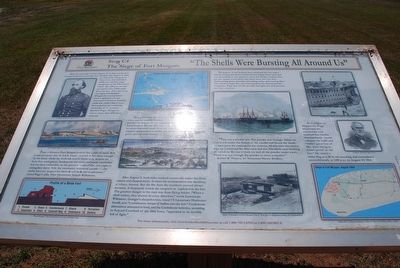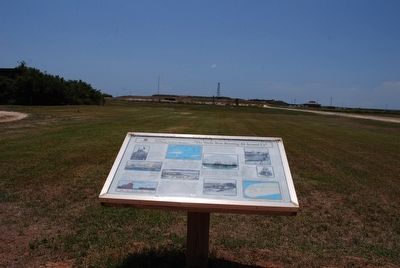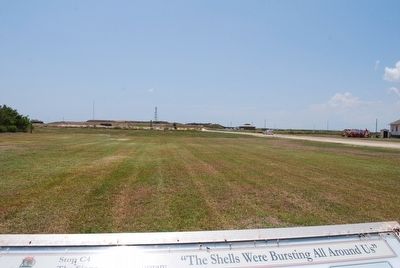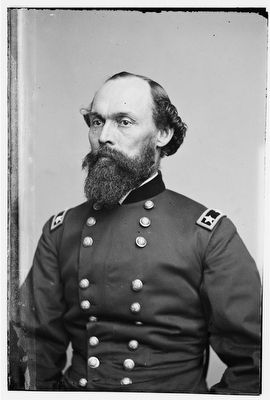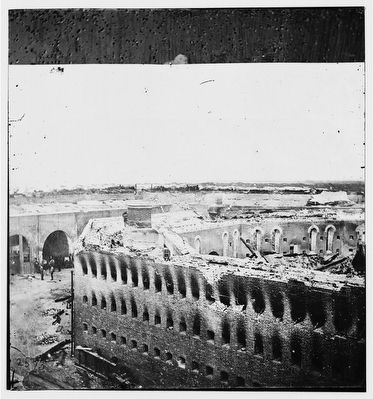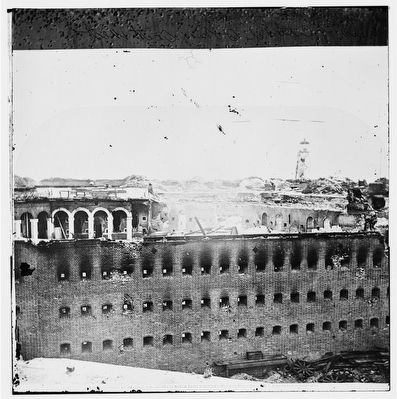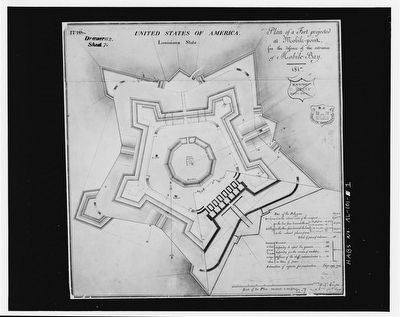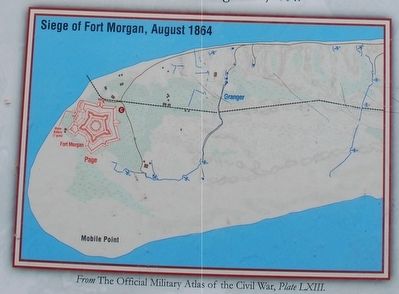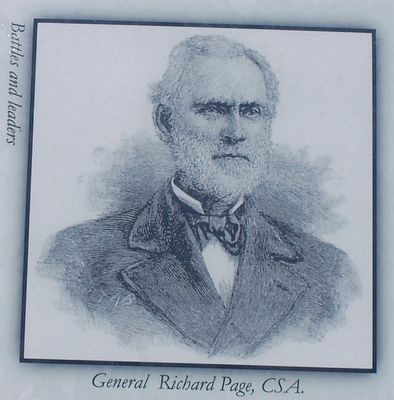Near Gulf Shores in Baldwin County, Alabama — The American South (East South Central)
"The Shells Were Bursting All Around Us"
The Siege of Fort Morgan:
— Stop C4 —
After the surrender of Fort Gaines, U.S. General Gordon Granger prepared to besiege Fort Morgan. On August 9, 1864, he moved by transport to Navy Cove and debarked 2,000 men and his siege equipment at the Pilot Town wharf. By 2:00 p.m. he had occupied a line 2,000 yards from the fort. That afternoon Farragut bombarded Morgan for several hours from a distance of one thousand yards, and, under a flag of truce, demanded its unconditional surrender. C.S. General Richard Page, though he had no more than 600 men, refused.
From a distance Fort Morgan looked like a pile of sand. But it was no secret that its brick would crumble if hit often enough by the heavy shells the Federals would throw at it, despite its forty foot sand glacis. Inadequate traverse and weak casemates left the men vulnerable, so the garrison worked day and night to strengthen them. Still, the casemates remainded unsafe: "...the shells have no respect for them & roll in & out at pleasure," noted Page's aide, First Lieutenant Joseph Wilkinson.
Granger's army, by the end of the siege numbering 5,500 men, moved steadily forward. The Yankees completed their first parallel on August 10 and mounted their siege guns, including naval battery. On the 15th they started their second parallel, five to seven hundred yards from the fort. By the 21st the Union sappers approached to within 200 yards of the glacis. Their big guns moved even closer.
After August 9, both sides worked continually under fire from cannon and sharpshooters. At times the bombardment was desultory; at others, intense. But the fire from the monitors seemed always accurate. It frequently struck the ramparts or exploded in the fort. The greatest danger to the men was from flying bricks. "When a shell strikes, they shower in every direction," wrote Lieutenant Wilkinson. Granger's sharpshooters, noted CS Lieutenant Hurieosco Austill, sent "a continuous stream of bullets over the fort." Confederate skirmishers answered in kind, and the Confederate batteries, according to Samuel Crawford of the 20th Iowa, "appeared to be terrible full of fight."
On August 22 the Federal fleet encircled the fort and a furious twenty four hour bombardment began from land and sea. According to one observer, once the Yankee artillerymen got the range, every shell they fired went into the fort, dismounting guns, partially breaching walls, and starting fires. The citadel caught fire and, burning fiercely, threatened the magazine. Page had all the powder brought out and poured into the cisterns.
"This was a terrible job. The powder was in kegs, These we had to roll under the flames of the citadel and knock the heads in, then pour the contents in the cisterns. All this time the enemy kept up a continual fire from land and sea. The shells were bursting all around us. By one o'clock we had all the powder under water. There was not enough dry powder to shoot a musket."
Robert B. Tarpley, 1st Tennessee Heavy Artillery
At daylight on August 23, Page inspected his casemates and realized that further bombardment would collapse the walls and "inflict great loss of life, there being no bomb-proof in the fort." He raised a white flag at 6:30 in the morning and surrendered unconditionally at 2:00 p.m. on August 23, 1864.
Erected by Civil War Trail Battle for Mobile Bay. (Marker Number Stop C4.)
Topics. This historical marker is listed in these topic lists: Forts and Castles • War, US Civil. A significant historical year for this entry is 1864.
Location. 30° 13.716′ N, 88° 1.147′ W. Marker is near Gulf Shores, Alabama, in Baldwin County. Marker can be reached from Fort Morgan Road, 1.4 miles Dune Road, on the left when traveling west. Touch for map. Marker is at or near this postal address: 110 AL-80, Gulf Shores AL 36542, United States of America. Touch for directions.
Other nearby markers. At least 8 other markers are within walking distance of this marker. The Battery Lincoln (about 700 feet away, measured in a direct line); The Pride of Seven Flags (approx. 0.2 miles away); Officer’s Row (approx. 0.2 miles away); Colors of Significance: Historic Flags of Mobile Point
(approx. 0.2 miles away); The Overland Campaign (approx. 0.2 miles away); 6.4” (100 pounder) Parrott Rifle / 7” Brooke Rifle (approx. 0.2 miles away); The Citadel (approx. 0.2 miles away); Citadel (1825-1865) (approx. ¼ mile away). Touch for a list and map of all markers in Gulf Shores.
Also see . . . Fort Morgan State Historic Site. (Submitted on August 16, 2015.)
Credits. This page was last revised on August 25, 2018. It was originally submitted on August 16, 2015, by Brandon Fletcher of Chattanooga, Tennessee. This page has been viewed 1,657 times since then and 56 times this year. Photos: 1, 2, 3, 4, 5, 6, 7, 8, 9. submitted on August 16, 2015, by Brandon Fletcher of Chattanooga, Tennessee. • Bernard Fisher was the editor who published this page.
